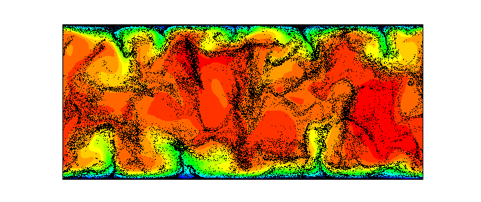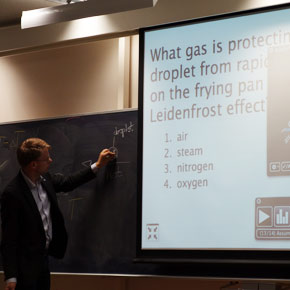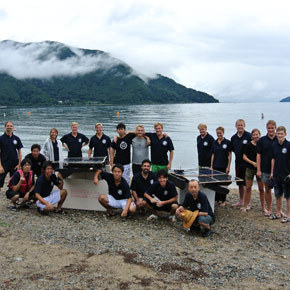Introduction to Multiphase Flows
with applications to microfluidics, biofluids, energy and material processing
The University of Tokyo, Oct 30-Nov 16, 2012
By Professor Fredrik Lundell (KTH)

Particles in a turbulent channel flow. Flow is into the plane of the image. The colours indicate streamwise velocity and the dots show the positions of individual particles (Zhao & Andersson, Phys. Fluids)
Lecturer:
Professor Fredrik Lundell, Department of Mechanics, Royal Institute of Technology (KTH), Sweden. He is the winner of ”Teacher of the year, 2011”.
This course will give you:
a. An introduction to the physics of flows with spherical and non-spherical particles and gas-liquid flows.
b. The possibility to experience Peer Instruction, a teaching method focussing on discussion and understanding in class.
c. Improved discussion and arguing skills in English.
*The course is for graduate students in Departments of Mechanical Engineering, Systems Innovation, and Precision Engineering (but undergraduate students can also audit).
Number of credits:2
To earn credits, attendants should register for the course 「精密工学特別講義VI」at Department of Precision Engineering.
The workflow in the course will be:
1. The material to be covered are read (maximum time: 1,5 hour), a reading report is submitted at latest 2h before the session (see page 3).
2. The content is discussed during the sessions using concept questions, clickers and peer instruction.
3. Before the final session, you will read a paper together with two course mates. The paper will illustrate how the concepts from the course are used in applications.
4. At the last session, you will present the paper for your course mates during 15-20 minutes.
Typical flow of the Peer Instruction
1. Instructor poses question based on students' responses to their pre-class reading
2. Students reflect on the question
3. Students commit to an individual answer
4. Instructor reviews student responses
5. Students discuss their thinking and answers with their peers
6. Students then commit again to an individual answer
7. The instructor again reviews responses and decides whether more explanation is needed before moving on to the next concept
Material
The reading material will be taken from (copies of the relevant pages will be available):
[1] Multiphase flow with droplets and particles by Crowe, Sommerfeld and Tsuji, pp. 1-35, 57-85.
[2] Multiphase flows by Brennen, pp. 150-160.
[3] The rheology of fibre suspensions by Petrie, J. Non-Newtonian Fluid Mechanics 87 (1999), pp. 369-377.
Detailed program
| Date/Place | Subject | Literature |
|---|---|---|
| Session 1: Oct. 30, 16:40-18:20 /Eng. Bldg. 2, rm. 223 |
Introduction Course structure and workflow Applications Phase coupling |
[1] pp. 1-23 |
| Session 2: Nov. 2, 16:40-18:20 /Eng. Bldg. 2, rm. 223 |
Fundamentals Response times, Stokes number Phase coupling, cont. |
[1] pp. 24-35 |
| Session 3: Nov. 6, 16:40-18:20 /Eng. Bldg. 2, rm. 223 |
Particle fluid interaction Single particle equations Mass coupling Particle drag forces |
[1] pp. 57-85 |
| Session 4: Nov. 9, 16:40-18:20 /Eng. Bldg. 2, rm. 223 |
Non-spherical particles Rotational velocity Rotational diffusion Smoluchowski equation |
[2] pp. 369-377 |
| Session 5: Nov. 13, 16:40-18:20 /Eng. Bldg. 2, rm. 223 |
Boiling and condensation Pool boiling Critical heat flux Vertical surfaces |
[3], pp. 150-160 |
| Session 6 Nov. 16, 16:40-18:20 /Eng. Bldg. 2, rm. 223 |
Multiphase flow in micro channels Evaluation Material covered Teaching method |
Will be announced Nov. 9. |
| Session 7 TBD |
Present topics and frontiers Student presentations |
Paper of your choice or from a list! |

